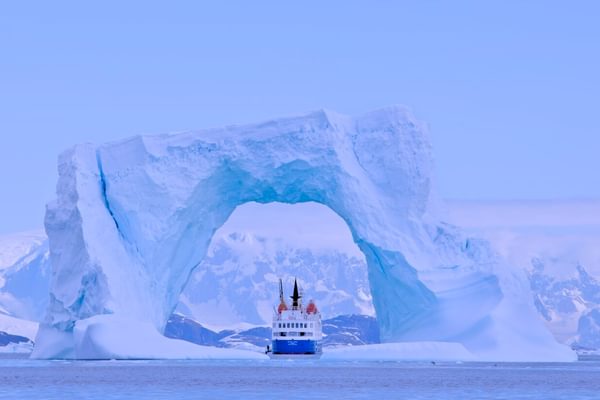A Wildlife Haven in the Southern Hemisphere
This British overseas territory, comprising over 700 islands, boasts awe-inspiring landscapes, abundant wildlife, and a rich history waiting to be explored.
In the vast expanse of the Southern Atlantic Ocean lies the remote Falkland Islands, a destination that promises an unforgettable adventure for nature enthusiasts and wildlife lovers alike.
Geographically, the Falkland Islands are situated about 300 miles off the southeastern coast of South America. Despite their relatively small size, the archipelago's diverse terrain is a feast for the eyes. From dramatic cliffs and white sandy beaches to rolling hills and vast open plains, the scenery offers an unparalleled sense of tranquillity and wonder.
One of the prime attractions of the Falkland Islands is its astonishing wildlife. The archipelago is a haven for diverse animal species, with over 100,000 breeding pairs of penguins, including the charismatic Magellanic, Gentoo, and King penguins. Birdwatchers will be equally enthralled by the vast populations of albatrosses, petrels, and cormorants.
For those seeking to witness wildlife up close, a visit to Sea Lion Island and Volunteer Point is a must. These locations offer incredible opportunities to observe sea lions, elephant seals, and, if you're lucky, even killer whales patrolling the coastal waters. The fascinating display of interactions between predator and prey is a sight that will leave travellers in awe.
Beyond its wildlife wonders, the Falkland Islands have a rich history to explore. Delve into the captivating stories of battles and conflicts as you visit historical sites, including the remnants of the 1982 Falklands War, an event that shaped the islands' modern identity.
Adventurous travellers can embark on hikes along scenic trails, explore shipwrecks on pristine beaches, and engage in thrilling water-based activities such as kayaking and scuba diving.
Whether you're a nature enthusiast or a history buff, the Falkland Islands offer an unforgettable experience that connects you to the raw beauty of nature and the intriguing tales of the past.
Falkland Islands Trip Inspiration
When to go to the Falkland Islands
Best time to go to the Falkland Islands.
- Best
- Good
- Mixed
- Jan
- Feb
- Mar
- Apr
- May
- Jun
- Jul
- Aug
- Sep
- Oct
- Nov
- Dec
January
In January, the Falkland Islands embrace summer, with temperatures averaging around 10-15°C (50-59°F). This warm season invites travellers to explore breathtaking landscapes and indulge in outdoor activities like hiking and fishing. Wildlife enthusiasts will be in awe as penguin chicks hatch, seal pups are born, and various bird species nest, making it an excellent time for wildlife watching. Though occasional rainfall and strong winds can be expected, the allure of witnessing the island's incredible wildlife interactions makes January an unforgettable time to visit.
February
Continuing the warm trend of January, February in the Falkland Islands offers similar temperatures, making it a prime time for wildlife observation. Penguin colonies thrive with activity, and a plethora of seabirds make their nests. While rainfall decreases slightly, gusty winds may still sweep through the islands. Joining a wildlife tour to witness the bustling wildlife communities is a highlight of the month.
March
March ushers in the autumn season, and the temperatures begin to cool slightly. As migratory bird species start to arrive, birdwatchers will be delighted with this month's wildlife sightings. Despite more frequent showers and gusty winds, the Falkland Islands remain a fascinating destination to explore the settlements, visit museums, and delve into the island's rich history and culture.
April
In April, the Falkland Islands enter autumn, displaying seasonal landscapes adorned with vibrant hues. As temperatures range from 5-10°C (41-50°F), visitors can enjoy exploring walking trails in the peaceful atmosphere of the off-season. Though rainfall increases, the island still has much to offer.
May
Winter begins to creep in in May, which brings cooler temperatures, with average ranges of 1-7°C (34-45°F). Rainfall continues, and snow showers are possible. Nevertheless, this month offers unparalleled opportunities for marine life observation, including the chance to witness whales and dolphins. Sea fishing is also a popular activity, and travellers can enjoy warm, hearty Falkland cuisine to offset the cold.
June
Mid-winter in the Falkland Islands presents chilly temperatures and occasional frost. With snow and sleet possible, especially in higher elevations, the landscape takes on a picturesque winter charm. Wildlife viewing opportunities thrive during this time, as large congregations of penguins and other animals capture the attention of all who visit. Additionally, clear nights are perfect for stargazing.
July
July marks the heart of winter in the Falkland Islands, with cold temperatures and occasional snowfall. While rainfall decreases, the islands remain cold and windswept. Adventurous travellers will appreciate the unique experience of witnessing the Falklands in its winter glory, capturing stunning photographs of penguins against snowy backdrops and engaging with friendly locals in cozy pubs.
August
With winter persisting in August, travellers can expect cold temperatures and the possibility of snow. Rainfall diminishes further during this month, and while winds can still be strong, the Falklands' natural beauty remains captivating. Wildlife enthusiasts will find incredible opportunities to photograph penguins in their winter surroundings, and exploring the scattered shipwrecks along the coastline adds an element of adventure to the journey.
September
Spring slowly makes its entrance in September, bringing milder temperatures ranging from 5-12°C (41-54°F). While winds may still be strong, the rainfall decreases further. This month welcomes the arrival of migratory birds, adding to the already diverse birdwatching opportunities. Exploring the various nature reserves and protected areas becomes a rewarding pursuit during this transitional time.
October
As spring continues to bloom, October in the Falkland Islands presents pleasant temperatures ranging from 8-15°C (46-59°F). With longer days and reduced rainfall, this month provides an excellent opportunity for hiking and exploring the islands' unique geological features. Engaging in ecotourism activities and supporting local conservation efforts will grant travellers a deeper understanding of the island's delicate ecosystem.
November
In November, summer officially graces the Falkland Islands with temperatures averaging around 10-16°C (50-61°F). Longer daylight hours offer ample time for exploration, making it an ideal season to engage in outdoor activities like boating, wildlife tours, and picnics on scenic beaches. Capturing the islands' stunning landscapes with a camera becomes an enchanting pastime during this picturesque month.
December
The Falkland Islands welcome the height of summer in December, offering warmer temperatures and longer days with an average range of 10-15°C (50-59°F). While winds remain generally milder, the possibility of occasional rainfall adds to the island's natural charm. Travelers can make the most of the extended daylight hours to embark on various adventures and explore the Falklands in all its summer splendour, making cherished memories that will last a lifetime.
Best places to stay for the Falklands
Speak to a Falkland Islands expert today
and start planning your tailor-made holiday

Amanda
Falkland Islands Expert



































